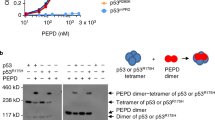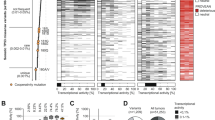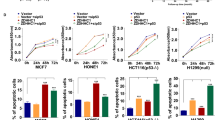Abstract
The p53 tumor suppressor protein induces apoptosis through a mechanism that may involve the transcriptional activation of cellular genes, including the PIG3 gene. A p53 protein lacking the proline-rich region (p53Δ62-91) induces many p53-responsive genes but not PIG3. In parallel, this mutant induces growth arrest but not apoptosis. We show here that the replacement of the N-terminal (amino acids 1–80) or C-terminal (amino acids 344–393) domains of p53 with heterologous domains does not interfere with transcription from the PIG3 promoter, but these chimeras still require the proline-rich region for PIG3 activation. The p53-homolog p73β also activated the PIG3 promoter, but in contrast to p53, the proline-rich domain of p73β (residues 81–113) was dispensable to induce the PIG3 promoter. Some tumor-derived p53-mutants, especially M246I, retained the ability to activate transcription of mdm2 but specifically failed to induce the PIG3 promoter, thus resembling p53Δ62-91. Further, p53Δ62-91 and p53M246I were defective for induction of apoptosis. Finally, p53Δ62-91 and p53M246I both showed reduced binding to the DNA of the PIG3 promoter and also to the DNA of the mdm2 and p21 promoters in vitro. Correspondingly, at low expression levels, p53Δ62-91 and p53M246I poorly activated the mdm2 promoter when compared to wild type p53. Our results suggest that the proline-rich domain of p53 affects the ability of the central domain to bind DNA. Moreover, some tumor-derived mutations within the central DNA binding domain of p53 mimic the loss of the proline-rich domain.
This is a preview of subscription content, access via your institution
Access options
Subscribe to this journal
Receive 50 print issues and online access
$259.00 per year
only $5.18 per issue
Buy this article
- Purchase on Springer Link
- Instant access to full article PDF
Prices may be subject to local taxes which are calculated during checkout









Similar content being viewed by others
References
Agami R, Blandino G, Oren M and Shaul Y . 1999 Nature 399: 809–813
Brachmann RK, Yu K, Eby Y, Pavletich NP and Boeke JD . 1998 EMBO J 17: 1847–1859
Chen X, Ko LJ, Jayaraman L and Prives C . 1996 Genes Dev 10: 2438–2451
Cho Y, Gorina S, Jeffrey PD and Pavletich NP . 1994 Science 265: 346–355
Dobbelstein M and Shenk T . 1996 J Virol 70: 6479–6485
Ellenberger TE, Brandl CJ, Struhl K and Harrison SC . 1992 Cell 71: 1223–1237
Freedman DA, Epstein CB, Roth JC and Levine AJ . 1997 Mol Med 3: 248–259
Gong JG, Costanzo A, Yang HQ, Melino G, Kaelin Jr WG, Levrero M and Wang JY . 1999 Nature 399: 806–809
Gu W and Roeder RG . 1997 Cell 90: 595–606
Harris CC . 1996 Carcinogenesis 17: 1187–1198
Hu JC, O'Shea EK, Kim PS and Sauer RT . 1990 Science 250: 1400–1403
Hupp TR, Meek DW, Midgley CA and Lane DP . 1992 Cell 71: 875–886
Jackson P, Bos E and Braithwaite AW . 1993 Oncogene 8: 589–597
Jayaraman L, Moorthy NC, Murthy KG, Manley JL, Bustin M and Prives C . 1998 Genes Dev 12: 462–472
Jayaraman L, Murthy KG, Zhu C, Curran T, Xanthoudakis S and Prives C . 1997 Genes Dev 11: 558–570
Jost CA, Marin MC and Kaelin Jr WG . 1997 Nature 389: 191–194
Kaelin Jr WG . 1999 J Natl Cancer Inst 91: 594–598
Kaghad M, Bonnet H, Yang A, Creancier L, Biscan JC, Valent A, Minty A, Chalon P, Lelias JM, Dumont X, Ferrara P, McKeon F and Caput D . 1997 Cell 90: 809–819
König C, Roth J and Dobbelstein M . 1999 J Virol 73: 2253–2262
Levine AJ . 1997 Cell 88: 323–331
Meek DW . 1998 Cell Signal 10: 159–166
Minaguchi T, Kanamori Y, Matsushima M, Yoshikawa H, Taketani Y and Nakamura Y . 1998 Cancer Res 58: 4585–4586
Nikolova PV, Henckel J, Lane DP and Fersht AR . 1998 Proc Natl Acad Sci USA 95: 14675–14680
Pietenpol JA, Tokino T, Thiagalingam S, el-Deiry WS, Kinzler KW and Vogelstein B . 1994 Proc Natl Acad Sci USA 91: 1998–2002
Polyak K, Xia Y, Zweier JL, Kinzler KW and Vogelstein B . 1997 Nature 389: 300–305
Rosenthal AN, Ryan A, Al-Jehani RM, Storey A, Harwood CA and Jacobs IJ . 1998 Lancet 352: 871–872
Roth J, König C, Wienzek S, Weigel S, Ristea S and Dobbelstein M . 1998 J Virol 72: 8510–8516
Ruaro EM, Collavin L, Del Sal G, Haffner R, Oren M, Levine AJ and Schneider C . 1997 Proc Natl Acad Sci USA 94: 4675–4680
Ryan KM and Vousden KH . 1998 Mol Cell Biol 18: 3692–3698
Sakamuro D, Sabbatini P, White E and Prendergast GC . 1997 Oncogene 15: 887–898
Sionov RV, Moallem E, Berger M, Kazaz A, Gerlitz O, Ben-Neriah Y, Oren M and Haupt Y . 1999 J Biol Chem 274: 8371–8374
Storey A, Thomas M, Kalita A, Harwood C, Gardiol D, Mantovani F, Breuer J, Leigh IM, Matlashewski G and Banks L . 1998 Nature 393: 229–234
Sun XF, Johannsson O, Hakansson S, Sellberg G, Nordenskjold B, Olsson H and Borg A . 1996 Oncogene 13: 407–411
Taylor JA, Li Y, He M, Mason T, Mettlin C, Vogler WJ, Maygarden S and Liu E . 1996 Cancer Res 56: 294–298
Thomas M, Kalita A, Labrecque S, Pim D, Banks L and Matlashewski G . 1999 Mol Cell Biol 19: 1092–1100
Unger T, Mietz JA, Scheffner M, Yee CL and Howley PM . 1993 Mol Cell Biol 13: 5186–5194
Venot C, Maratrat M, Dureuil C, Conseiller E, Bracco L and Debussche L . 1998 EMBO J 17: 4668–4679
Walker KK and Levine AJ . 1996 Proc Natl Acad Sci USA 93: 15335–15340
White E and Prives C . 1999 Nature 399: 734–735, 737
Yang A, Kaghad M, Wang Y, Gillett E, Fleming MD, Dotsch V, Andrews NC, Caput D and McKeon F . 1998 Mol Cell 2: 305–316
Yu J, Zhang L, Hwang PM, Rago C, Kinzler KW and Vogelstein B . 1999 Proc Natl Acad Sci USA 96: 14517–14522
Yuan ZM, Shioya H, Ishiko T, Sun X, Gu J, Huang YY, Lu H, Kharbanda S, Weichselbaum R and Kufe D . 1999 Nature 399: 814–817
Zhu J, Jiang J, Zhou W and Chen X . 1998 Cancer Res 58: 5061–5065
Zhu J, Jiang J, Zhou W, Zhu K and Chen X . 1999 Oncogene 18: 2149–2155
Acknowledgements
We thank H-D Klenk and R Arnold for their continuous support. We are indebted to B Vogelstein for the generous gift of plasmids and helpful advice. We also thank J Pietenpol and A Levine for plasmids; W Deppert and S Dehde for early passage H1299 cells. M Eilers, R Müller, M Beato and M Scheffner for helpful discussion. This work was supported by the German research foundation and the PE Kempkes foundation. A Contente received a fellowship from the European Union (Praxis XXI), and M Dobbelstein was a recipient of the Stipendium für Infektionsbiologie by the German cancer research center during this work.
Author information
Authors and Affiliations
Rights and permissions
About this article
Cite this article
Roth, J., Koch, P., Contente, A. et al. Tumor-derived mutations within the DNA-binding domain of p53 that phenotypically resemble the deletion of the proline-rich domain. Oncogene 19, 1834–1842 (2000). https://doi.org/10.1038/sj.onc.1203500
Received:
Revised:
Accepted:
Published:
Issue Date:
DOI: https://doi.org/10.1038/sj.onc.1203500
Keywords
This article is cited by
-
The relationship of TP53 R72P polymorphism to disease outcome and TP53 mutation in myelodysplastic syndromes
Blood Cancer Journal (2015)
-
RIP1 maintains DNA integrity and cell proliferation by regulating PGC-1α-mediated mitochondrial oxidative phosphorylation and glycolysis
Cell Death & Differentiation (2014)
-
p53-mediated apoptosis prevents the accumulation of progenitor B cells and B-cell tumors
Cell Death & Differentiation (2010)
-
Modulation of microRNA processing by p53
Nature (2009)
-
p53 polymorphisms: cancer implications
Nature Reviews Cancer (2009)



